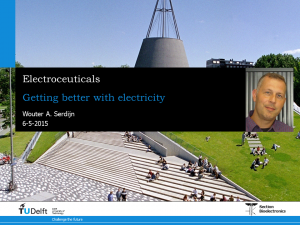
Injectable electronics still need to become smaller
Frequent readers of this weblog may still remember a previous post, entitled “And the paralyzed will walk again“. This phrase comes from a Discovery Channel movie/documentary, called “2057: the body”, in which it is predicted that by the year 2057 you will be able to survive a three story fall and even be able to walk again as there will be tiny microstimulators attached to your muscles, which can be injected.
Injectable electronics, how fascinating would that be! No more lengthy surgeries, during which only a single, bulky device is implanted, but rather a procedure that takes less than a couple of minutes, during which multiple micro-stimulators are inserted via a seringe. Once done, these stimulators will form a wireless network and will provide the motory neural pathway with well-timed electric stimuli necessary to evoke the correct contraction of the multiple muscles involved in a delicate movement or even seemingly simple posture control.
But how feasible is this idea of injectable electronics? If you search for the term injectable electronics, you will most likely find a lot of references to the work of John Rogers, professor at the University of Illinois in the US, who built “an electronic LED device so tiny it can be injected into delicate tissue, such as in the brain, without harming it“.
Other links that can be found refer to work done on silk implants or even magnesium implants that are either stretchable or can easily dissolve into the body once the good work has been done.
I personally believe that we only can create injectable electronic devices if they have at least some intelligence in them. For this, the good old silicon would be an excellent candidate. Silicon is a nice and friendly biocompatible material, can be made bendable (by thinning the substrate) or stretchable (by removing the substrate altogether at some points). And what’s more, silicon can accommodate stimulation circuitry, sensors, signal processing, communication electronics, antennas, battery foils, all the good stuff needed to make a good injectable.
Of course, in order not to damage the tissue that the electronic device is injected in, it needs to be small, i.e., thin and narrow. It is however allowed to make it long, e.g., a couple of millimeters up to one or two centimeters. These unconventional dimensions raise very exciting technological challenges, such as:
- how can we create electronic integrated circuits (ICs) that are merely one-dimensional, i.e., are not wider than one, maximally two, bondpads?
- how can we transfer information and energy to an implant that has virtually no area?
- what kind of material should we use for the antenna and electrodes?
- will a Li-Ion battery foil have enough capacity to provide successful stimulation of the tissue, or should we refrain from using batteries altogether?
There obviously is still a lot to do. Exciting stimes ahead, if you ask me.
Wouter


 Opinion paper in Trends in Biotechnology
Opinion paper in Trends in Biotechnology

